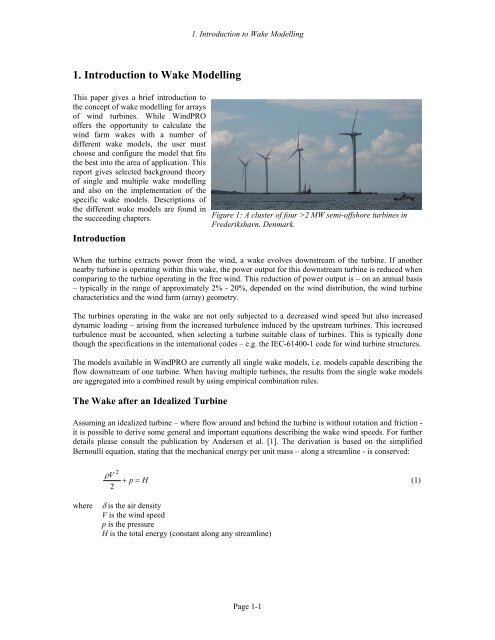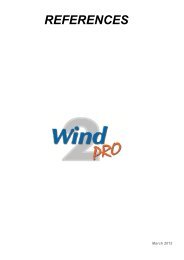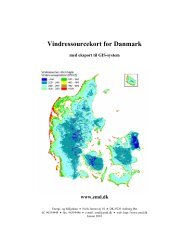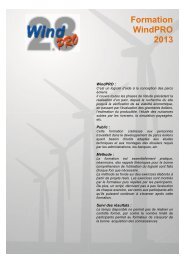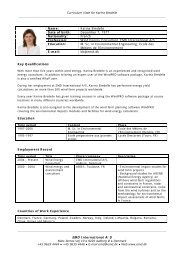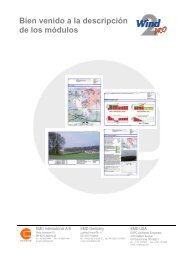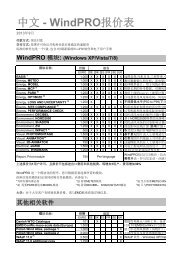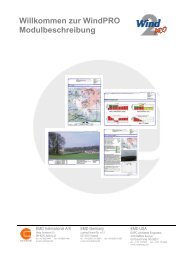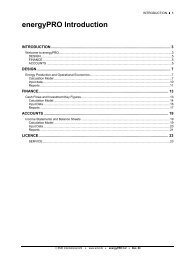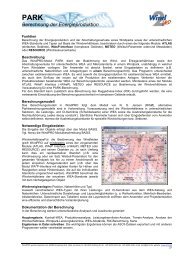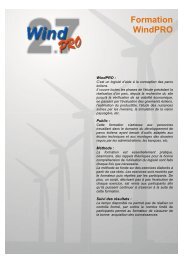WindPRO / PARK - EMD International AS.
WindPRO / PARK - EMD International AS.
WindPRO / PARK - EMD International AS.
Create successful ePaper yourself
Turn your PDF publications into a flip-book with our unique Google optimized e-Paper software.
1. Introduction to Wake Modelling<br />
1. Introduction to Wake Modelling<br />
This paper gives a brief introduction to<br />
the concept of wake modelling for arrays<br />
of wind turbines. While <strong>WindPRO</strong><br />
offers the opportunity to calculate the<br />
wind farm wakes with a number of<br />
different wake models, the user must<br />
choose and configure the model that fits<br />
the best into the area of application. This<br />
report gives selected background theory<br />
of single and multiple wake modelling<br />
and also on the implementation of the<br />
specific wake models. Descriptions of<br />
the different wake models are found in<br />
the succeeding chapters.<br />
Introduction<br />
Figure 1: A cluster of four >2 MW semi-offshore turbines in<br />
Frederikshavn, Denmark.<br />
When the turbine extracts power from the wind, a wake evolves downstream of the turbine. If another<br />
nearby turbine is operating within this wake, the power output for this downstream turbine is reduced when<br />
comparing to the turbine operating in the free wind. This reduction of power output is – on an annual basis<br />
– typically in the range of approximately 2% - 20%, depended on the wind distribution, the wind turbine<br />
characteristics and the wind farm (array) geometry.<br />
The turbines operating in the wake are not only subjected to a decreased wind speed but also increased<br />
dynamic loading – arising from the increased turbulence induced by the upstream turbines. This increased<br />
turbulence must be accounted, when selecting a turbine suitable class of turbines. This is typically done<br />
though the specifications in the international codes – e.g. the IEC-61400-1 code for wind turbine structures.<br />
The models available in <strong>WindPRO</strong> are currently all single wake models, i.e. models capable describing the<br />
flow downstream of one turbine. When having multiple turbines, the results from the single wake models<br />
are aggregated into a combined result by using empirical combination rules.<br />
The Wake after an Idealized Turbine<br />
Assuming an idealized turbine – where flow around and behind the turbine is without rotation and friction -<br />
it is possible to derive some general and important equations describing the wake wind speeds. For further<br />
details please consult the publication by Andersen et al. [1]. The derivation is based on the simplified<br />
Bernoulli equation, stating that the mechanical energy per unit mass – along a streamline - is conserved:<br />
ρV<br />
2<br />
2<br />
+ p = H<br />
(1)<br />
where<br />
δ is the air density<br />
V is the wind speed<br />
p is the pressure<br />
H is the total energy (constant along any streamline)<br />
Page 1-1


